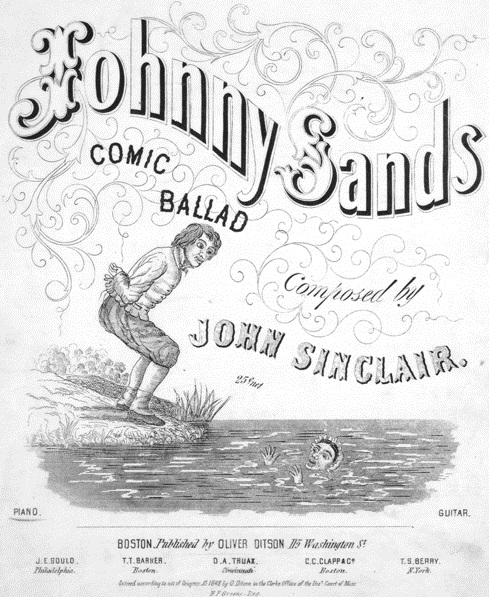Johnny Sands è la versione americana di un’esilarante “comic ballad” della tradizione britannica conosciuta genericamente sotto il titolo di Marrowbones. Si racconta la storia di un uomo che con uno stratagemma, uccide la moglie infedele.
Marrowbones Family
La storia è giunta dall’Ottocento in una miriade di versioni e la località di provenienza dei protagonisti varia tra Wexford, Belfast, Dublino o Kelso, ma anche Oxford .
Versioni scozzesi
Toon Of Kelso (“Auld Woman o Kelso”, “The Wife of Kelso”)
Versioni irlandesi
Old Woman from Wexford
Tipping It Up To Nancy
Versioni americane
Johnny Sands
La ballata si diffonde anche in America con il titolo di “Johnny Sands”; John Kirkpatrick canta “Johnny Sands” nel 1977 e nelle note di commento dell’album “Shreds and Patches” è scritto: There are two forms of this song. In the oldest form, the wife has her husband eat marrowbones in the hope of making him blind (She is told that “when he’s sucked all the marrow out, he won’t see nothing at all”). He professes not to be able to help her when she accidentally falls in the water. In that shape the song circulated for several centuries. The later form of the song, similar to the one that John sings here, dispenses with the blindness bit. It is probably the work of an American singer-entertainer, John Sinclair, who published it in 1842. So many stage comedians and singing groups took it up that it became extraordinarily current throughout the United States, Britain and Ireland during the remainder of the nineteenth century, and has lingered on in the memory of country singers, alongside the “marrowbones” version. John’s version was sung to the blind folk song collector Fred Hamer, by a Shropshire singer named Saunders.
LA VERSIONE AMERICANA: JOHNNY SANDS
Nelle versioni americane la ballata è priva dell’antefatto per cui veniamo semplicemente a sapere che Johnny è malato e sofferente, e preferisce andare al fiume ad annegarsi così chiede alla moglie di aiutarlo: una volta arrivati sul posto, per essere sicuro che tutto vada per il verso giusto chiede alla moglie di legargli le mani dietro la schiena e di dargli una grossa spinta dopo aver preso una bella rincorsa.
Vediamo la donna affannarsi a correre verso la sponda del fiume .. e proseguire la sua corsa in acqua poiché l’astuto marito si scansa di lato! Inutilmente lei si dibatte e chiede aiuto, il marito le risponde che anche se lo volesse non potrebbe farlo perchè ha le mani legate dietro la schiena!!
Così l’handicap della cecità nelle versioni britanniche viene sostituito sui Monti Appalachi dalle mani legate, ma questa modifica getta nuova luce anche sulla prima versione: la cecità del marito è solo presunta e finalizzata a trarre in inganno la moglie ritenuta responsabile di qualche piaga o maleficio (ad esempio l’impotenza) (prima parte)
ASCOLTA Sally Rogers, “The Unclaimed Pint” 1979
I There was a man named Johnny Sands. He married a Betsy Hague. Although she was a lovin’ wife, She proved a terrible plague. II Although she was a lovin’ wife, Full of caprice and whim, He said that he was tired of life And she was tired of him. III “I think I’ll go down and drown myself; The river it runs below.” She said, “Pray do, you silly oaf. I wished it long ago.” IV “For fear that I the courage lack, And try to save my life, You tie my hands behind my back.” “I will,” replied his wife. V So she tied his hands behind his back, And when securely done, “‘Tis I shall stand here on the brink, And you prepare to run.” VI So over the hill this lovin’ wife Ran with all her force To push him in. He stepped aside, And in she fell in, of course. VII Splashin’ round just like a fish, Cried, “Save me, Johnny Sands!” “I would, my dear, for much I wish, But you have tied my hands.” | traduzione italiana Cattia Salto I C’era un uomo di nome Johnny Sands che sposò Betsy Haugue e sebbene lei sembrasse una moglie amorevole si rilevò una terribile piaga. II Sebbene fosse una moglie amorevole piena di ricci e capricci lui disse che era stanco della vita come lei era stanca di lui III “Credo che andrò giù ad affogarmi nel fiume che scorre qui sotto” Dice lei “Fai pure, stupido zoticone se l’avessi fatto prima!” IV “Per paura che mi manchi il coraggio e cerchi di salvarmi la vita legami le mani dietro alla schiena” “lo farò” replicò la moglie V Così lei gli legò le mani dietro alla schiena e quando fu tutto a posto “Sto qui sulla riva e tu preparati a prendere la rincorsa” VI Così dalla collina questa donna amorevole, corse con tutte le sue forze per spingerlo dentro. Ma lui si spostò di lato e fu lei a cadere dentro! VII Tuffandosi come un pesce gridò “Salvami Johnny Sands!” “Vorrei, mia cara, o come lo vorrei ma tu mi hai legato le mani” |
FONTI
http://www.traditionalmusic.co.uk/folk-song-lyrics/Johnny_Sands.htm
http://mainlynorfolk.info/lloyd/songs/marrowbones.html
http://mudcat.org/thread.cfm?threadid=47275
https://jscholarship.library.jhu.edu/handle/1774.2/5334

